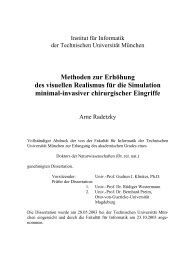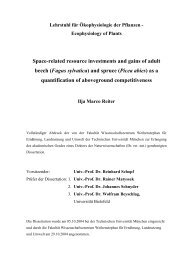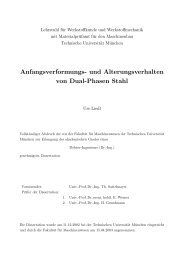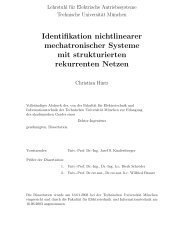Topologically Defined Neuronal Networks Controlled by Silicon Chips
Topologically Defined Neuronal Networks Controlled by Silicon Chips
Topologically Defined Neuronal Networks Controlled by Silicon Chips
You also want an ePaper? Increase the reach of your titles
YUMPU automatically turns print PDFs into web optimized ePapers that Google loves.
CHAPTER 2. NETWORKS OF DEFINED TOPOGRAPHY<br />
Figure 2.10: Simple model of two electrically coupled neurons. In this equivalent circuit each cell is<br />
represented <strong>by</strong> a single isopotential compartment. Neuron A is presynaptic, B postsynaptic.<br />
overall length is much smaller than λ, that means if they are electrotonically compact; for details refer<br />
to the previous subsection.<br />
Note that throughout this subsection voltage, capacitance and conductance are somatic quantities; the<br />
index ‘s’ used in the previous subsection to distinguish between somatic and neuritic quantities is omitted<br />
here. Capital letters denote the respective neuron the variable refers to.<br />
Injecting a constant current Iinj into neuron A causes a voltage response VA(t) in the presynaptic cell<br />
that is governed <strong>by</strong> the following differential equation, with Gsyn denoting the conductance of the<br />
synapse and V0A the resting potential of neuron A:<br />
dVA<br />
Iinj = CA<br />
dt + GA(VA − V0A) + Gsyn(VA − VB) (2.16)<br />
The current flowing across the synapse changes the voltage in the presynaptic neuron B, VB(t), according<br />
to the current balance:<br />
dVB<br />
Gsyn(VA − VB) = CB<br />
dt + GB(VB − V0B) (2.17)<br />
After transients have decayed, i.e. in the steady state where dVA/dt = dVB/dt = 0, the somatic<br />
voltages of A and B are:<br />
VA = V0A − GBGsyn(V0A − V0B)<br />
GAGB + Gsyn(GA + GB) +<br />
GB + Gsyn<br />
GAGB + Gsyn(GA + GB) Iinj<br />
VB = V0B + GAGsyn(V0A − V0B)<br />
GAGB + Gsyn(GA + GB) +<br />
Gsyn<br />
GAGB + Gsyn(GA + GB) Iinj<br />
(2.18)<br />
(2.19)<br />
Even if Iinj = 0, VA and VB are not equal to the resting potentials if V0A = V0B. This deviation is<br />
caused <strong>by</strong> a small permanent current which flows across the synapse, pulling the membrane voltages<br />
towards each other and away from the resting values.<br />
All unknown electrical parameters of the simple network in fig. 2.10, except for the membrane capacitances,<br />
can be obtained from steady state current measurements. In that case, current balances for each<br />
neuron before (index: 0) and after (index: ∞) a current step from Iinj,0 = 0 to Iinj,∞ are given <strong>by</strong>:<br />
22<br />
0 = GA(VA,0 − V0A) + Gsyn(VA,0 − VB,0) (2.20)<br />
Iinj,∞ = GA(VA,∞ − V0A) + Gsyn(VA,∞ − VB,∞) (2.21)<br />
Gsyn(VA,0 − VB,0) = GB(VB,0 − V0B) (2.22)<br />
Gsyn(VA,∞ − VB,∞) = GB(VB,∞ − V0B) (2.23)
















